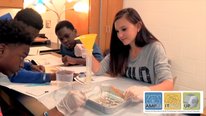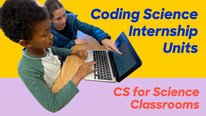NSF Awards: 1620910, 1620746
Teaching and understanding evolution is a challenge because it requires students to make connections across a number of different biological processes and scales. The ConnectedBio Project, a collaboration between the Concord Consortium and Michigan State University, has developed a set of free, online lessons and activities centered on a single phenomenon to help students see how these different biological processes, operating at different scales, work together to influence a single organismal trait.
ConnectedBio lessons integrate self-pacing, model building, and data collecting. Students are prompted to explore why deer mice have different fur colors in different subpopulations in the southern United States. Through scaffolded investigations, guided questions, and pointed analysis, students learn how natural history, cellular biology, molecular biology, inheritance, and population genetics all work together to influence a shift in fur color over time. Using an innovative multi-level simulation, students manipulate and examine these different processes at the population level, all the way down to the DNA level.
The goal of the ConnectedBio lessons and activities is to make understanding the process of evolution more accessible to high school students. By working with a focused and unified example, students are better able to make connections, and develop a nuanced understanding of evolution that is often elusive to students.
The ConnectedBio curriculum materials will be available to the public in July 2020.









Kiley McElroy-Brown
Project Manager & Scrum Master
We hope you enjoy our video featuring the ConnectedBio curriculum. These technology-enhanced lessons help high school students deepen their understanding of topics in biology across multiple levels of biological scale. Students investigate the phenomenon of deer mouse fur color through the use of our interactive simulation and data analysis tools. We are leveraging the unique affordances of technology in order to provide an environment for students to build a connected network of ideas from populations all the way down to genes and DNA.
The project is currently preparing to launch the curriculum for public use through the Concord Consortium's STEM Resource Finder by creating teacher resources that accompany our materials. We invite you to make comments and ask questions. Thanks for watching!
Kristin Flaming
Suzanne Orme
This is such an incredible way for students to learn biology. They will benefit from this interactive approach and from discovering the main ideas themselves. It seems much more effective than the traditional approach.
Frieda Reichsman
Senior Research Scientist
Thanks for watching our video Suzanne, glad we caught your eye. Currently we are working to support the remote implementations our research teachers have had to adopt due to covid-19. We plan to be able to support teachers who adopt the materials whether they are in the classroom or teaching remotely. This includes teacher guides and a teacher dashboard to track student progress.
Our research is examining the kinds of connections across levels of biological scale that students learning with ConnectedBio are making, and we have been able to use our findings to improve the support for making these connections in our materials.
We will be releasing the full curriculum to the public in July, and in fact we have two online activities available right now. Thanks for your comments.
Michael I. Swart
Susan Kowalski
I love how the project supports students in making connections across multiple levels of biological scale. Too often, students don't see how microscopic and macroscopic phenomena are related. Did teachers have difficulty in supporting students with the shift? How did you support teachers?
Rebecca Ellis
Research Associate
Hi Susan,
Thank you for your questions! As part of our focus was on connection, we developed several activities and functions within our lessons that scaffolded students' ability to bridge the scales. For example, we have students zoom from the mouse, into the melanocyte cell, and then to the membrane or nucleus. We also have probing and guiding questions along the way to call attention to the relationships between scales.
To help the teachers, we have created a Teacher Edition of our lessons. This version looks like the student version, except it includes time-specific tips and strategies, background information, and exemplar student responses. The Teacher Edition also includes points in the lessons where we recommend a full group discussion and provides resources to aid teachers in facilitating these discussions. For our pilot years, we have had monthly PD sessions with our master teachers, where we provide timely support as they implement. We have not formalized a plan yet for scaling the PD when we release, but would definitely be open to suggestions on how to best do this. Some ideas thus far have been to create informational videos that supplement the Teacher Edition, or to have sessions at conferences.
Jeffrey Ram
I'd love to see this software when you make it public in July. Probably a great remote learning tool. We all may need a lot more of that in the next year.
Rebecca Ellis
Research Associate
Hi, Jeffrey.
Absolutely! You can preview the technology currently on our website, and if you sign up, we will email you when the release begins. We also have some mini-lessons available now, for those who do not want to wait until July.
I agree - reliable online learning has become even more important in recent months. We have been having discussions on how we can best adapt our tool to make it even more usable for at-home learning.
Michael I. Swart
Jeffrey Ram
I'd love to see this software applied to food web analysis and the techniques used to study it. That's one of the major topics of teaching in our project at the Belle Isle Aquarium. STEM for ALL Showcase video
Kiley McElroy-Brown
Rebecca Ellis
Research Associate
When we finish the Deer Mouse Case, we will be looking to expand to other phenomena. Perhaps food web analysis should be added to our list!
Steven Greenstein
Associate Professor
That platform and curriculum DO like fun, fascinating, and interactive, as that one student said. The design of your technologies is really remarkable. It takes a complex process and makes it broadly accessible.
Have you learned anything about how students' beliefs interact with-- and are possibly shaped by -- their engagement with the curricular system? It does seem like the group-oriented aspect of engagement could provoke particularly personal meaningful discussions.
Kiley McElroy-Brown
Project Manager & Scrum Master
Hi Steven,
Thanks for your comment. We are very proud of what the ConnectedBio technology has shaped into over the course of this project. The ConnectedBio app or "Multi-Level Simulation" (MLS) has proven to be very powerful in providing students an environment to create this network of connected phenomena. (And it doesn't hurt that the mice are super cute!) The development team at the Concord Consortium has truly outdone themselves on this one!
From our observations in classrooms, students seem really invested in learning about the mice. As they talk, they bring up all sorts of interesting comments, which span several different types of levels (E.g. Should I get a mouse? Do mice have parents? Can we investigate the influence of the sun or diet on the mice?). In the early stages of the lessons, most students surmise that the environment and predation will be the driving factor in the evolution, and these features might even cause the cells of the mice to change in order to survive. With more experience, however, the students begin to see that DNA drives the process, with the environment and predation shaping which mutations are viable. From what we've seen in the pilot classrooms, conversation stays pretty on point. Students get engaged with the material, and explain things to each other. One student even used her hair to explain chromatin vs. chromosomes to her neighbor!
The interactive nature of the ConnectedBio app really allows students to bridge the technology with their hands-on experiences to create a multi-modal understanding of the fur color system.
Steven Greenstein
Brian Kruse
Thank you for sharing your video with us! It's really great to see the interactive investigations, and how they bring everything together to allow students to develop a more complete, integrated model of the functioning of organisms. It demonstrates how evolution truly is a foundational theory for all of biology!
Kiley McElroy-Brown
Frieda Reichsman
Senior Research Scientist
Brian, Thanks for your comment-- and a wonderful compliment!
Theodore Dobzhansky's statement that "Nothing in biology makes sense except in the light of evolution," is a guiding principle. As we help students and teachers to make connections so that they can see evolution as the logical, emergent property of biological processes, we make science accessible and help people reason about diverse phenomena. Thanks for your observations.
Ed Robeck
Director
Really fascinating use of modeling for explanation-building from evidence. I wonder, given how unusual it is in typical science education for students to engage in building arguments from evidence, do you have to acquaint the students with argumentation structures and techniques? That is, so they have a sense of the kinds of evidence they need to build (and potentially refute) their arguments?
Rebecca Ellis
Research Associate
Hi Ed,
Thank you for watching our video!
In one of our recent (remote) PD sessions with our master teachers, we brainstormed ways to help students develop their arguments using evidence in our lessons and activities. As this is a practice from NGSS, we have been looking for how to best incorporate it into our materials. Many of our master teachers use CER (claim-evidence-reasoning) with their students regularly, and use that language when also talking about the Deer Mouse, and that seems to transfer well.
That being said, we have built some of the CER structure into the materials itself, to scaffold the practice for students. For example, to start Unit 4, we have students make predictions about why some of the mice have a medium fur color, as opposed to the light and dark fur they have studied thus far. Then, we guide the students to use the multi-level simulation to explore the processes happening in a melanocyte cell of the medium colored fur, and determine what is causing its pigment production. We have the students compare what they found with their prediction, and then develop a model to express what they now know about medium fur color production. Finally, students describe their model as an explanation for what causes the medium fur. In this way, we guide students to develop their arguments based on facts, and provide them with both a simulation, and then a model, to use as they write up their answers. Some of our teachers have found that having the students compare models (by verbally explaining, not just showing) further engages students in thinking about the process of explanation and leads to stronger arguments.
In other words, while we don't formally introduce argumentation techniques in our lessons, we set up a structure for presenting arguments from evidence. This, along with teacher support, seems to be helping students to argue constructively.
Kristin Bass
This is such a wonderful curriculum! As your external evaluator, I've been especially impressed with your ability to elicit and respond to teacher feedback. You've been collaborating with an amazing set of teachers for several years. Can you say something about what you've learned from these teachers, and how they've informed the materials?
Rebecca Ellis
Research Associate
Thanks, Kristin!
First off, you are a wonderful external evaluator and you help our team immensely.
Second, you are right. The part of our master teachers has been invaluable to the development of these lessons and activities. During the first pilot year, the teachers took notes after each lesson, highlighting where they found areas confusing and what they really enjoyed. We then compiled all their feedback into a central spreadsheet, which we shared with the team (researchers, developers, teachers) in our summer PD week. From here, we focused on the major points and set a priority list for what should be updated and what should be kept. For example, these discussions led to a clearer style of nomenclature for the alleles, and added showing some dead mice at the population level to clarify the concept of generations to the students. We also learn much from the implementations in the classroom. I, and others, have been fortunate enough to conduct classroom observations while the master teachers teach, and as we see how they incorporate the materials into the classroom, we create notes for the Teacher Edition of the materials to help future teachers implement. For example, sometimes the teachers add a manipulative, or frame a discussion question in a particular way that we document for others to do the same in the future. Because of the hard work the teachers, both in their reflections and in their implementations, I am more confident that our lessons and activities work not only in theory, but in practice.
David Campbelll
Program Director (retired)
I wish I had this back when I was teaching biology. I was pleased to read Kiley’s comments describing how the simulation demonstrates that selection works on existing genetic variation. A common misconception is that the environment somehow “forces” mutations to occur. Did you anticipate misconceptions when you designed the simulation
Rebecca Ellis
Research Associate
Hi David,
Thanks for watching! Ah yes, the "force" misconception - We did anticipate this, and in fact, some of the early lessons and activities work to draw out this misconception, bringing it to the forefront. Unit 1 focuses on the environment and predation, and the class uses a Driving Question Board to highlight what students are wondering and thinking about for the relationship between fur color and these factors. We encourage teachers (in the Teacher Edition, an interactive online teacher guide) not to squash this misconception yet, but to let it linger and refer back to it as the lessons progress. In Units 2 and 3, students look closer at the proteins and DNA, and their opinions start to shift, as they wonder which factor drives which. In Unit 4, we move to inheritance, and here is when the conception makes a stronger shift, as they realize that fur color is strongly determined by the fur colors of the parents, via the alleles passed on through the gametes. By Unit 5, when they look at population genetics, students are pretty sold on the understanding that mutations in the DNA affect individual fur color, and the environment influences which mutations survive and thrive.
Through careful scaffolding of the curriculum and thoughtful tips for teachers, we have observed that our lessons and activities are successful in revealing the misconceptions that students may have had prior to and during the early lessons of ConnectedBio. As students advance through the materials and build a network of connections across levels, they are able to articulate why their misconception was just that — a misconception.
Melissa Kozuch
This tool is absolutely outstanding! The interactive approach is a great way to differentiate and get through to so many more students. For students to see things happening, in addition to reading and discussing, is a wonderful addition to any biology curriculum. I believe this could influence a student to go further into Biology than the traditional high school classroom. Connected Bio is definitely a positive contribution to the technology driven world we live in!
Kiley McElroy-Brown
Kiley McElroy-Brown
Project Manager & Scrum Master
Thank you for your kind words, Melissa! We certainly hoped that this technology-enhanced approach would encourage students to become more engaged in Biology as a discipline. While we have not done any formal research on whether our curriculum increases student interest or self-efficacy in science, we have certainly heard evidence that students find this curriculum engaging and enjoyable. Students have said things like "It's fun... it's more interactive than lecturing and a better way to learn." One student even said that the lessons and activities made him "feel like a scientist."
Hearing quotes like this from students tells us that we've made a difference in their experience in the classroom, and we consider that a major success. We're very excited to be able to share this curriculum with biology teachers in July 2020. If you're interested and haven't done so already, please sign up to be notified when the materials are available to the public!
Michael I. Swart
Catherine Stimac
I agree with comments thus far as it is becoming increasingly important to have resources like this available to teachers, students, and parents and caregivers. Great work!
Kiley McElroy-Brown
Project Manager & Scrum Master
Thank you for your kind words, Catherine! I will say the same for you and your efforts with A Medical Mystery. I really enjoyed watching your video and learning about the real-world examples you are using to encourage student-driven discovery with middle school students. I believe we are making similar strides in shaping wonderful resources for science education!
Catherine Stimac
I agree, Kiley. When we filmed teachers teaching content from the course with their students (clips of this are in our Stem for All video) for the PD it was so great to see first hand how excited and engaged the students were with M'Kenna's story. They were invested and wanted to do the work to help solve the mystery. And they actually asked for more when the course was complete. I haven't seen that happen before. I can see that same engagement in the students you worked with. It's encouraging!
Rebecca Brewer
As one of the pilot teachers of ConnectedBio who taught this curriculum to my AP Biology students these past few years, I can attest that these materials are some of the very best I have ever seen in my 20+ year teaching career! From outstanding graphics, to probing questions that require students to forge connections, to digital modeling components that showcase student understanding across multiple levels, every aspect of this curriculum has been crafted to engage and challenge students as they uncover the mechanisms underlying fur coloration. I highly recommend these materials to biology teachers nationwide seeking to break away from teaching biology content in silos and wanting their students to experience the interconnectedness of the biological sciences.
Michael I. Swart
Kiley McElroy-Brown
Kiley McElroy-Brown
Project Manager & Scrum Master
Thank you for your kind words, Rebecca! It's been a pleasure having you on our team of teachers. Not only have you allowed us to pilot our curriculum with your students, but your thoughtful feedback and insight from many years of teaching has helped us shape the ConnectedBio suite of materials into what it is today.
Michael I. Swart
Wow. Pictographic interactivity! Changes in Scale! Causal attributions! Complex Systems. Concept mapping. This is great. Thanks for sharing.
Do you have an publications on your design re-design processes and design changes you've made (UX, layout, art, representations), features added (Scaffolds, Instructions, Help, Adaptive Curriculum)? To this, what kind of metrics does game provide (content, user, attempts, time,embedded items, NLP/text analysis, screen capture, mouse data, etc.)
Frieda Reichsman
Senior Research Scientist
Hi Michael, thanks for asking! We have a few papers in progress and the first, which describes the curriculum and some of the reasoning behind the designs, has recently been submitted. So fingers crossed, we hope that it will be available before too long. ConnectedBio is not actually a game, so we do not have some of the metrics you mention that are more relevant to game play. However we do have user data on embedded assessments, from text-based to capturing the students’ models. Teachers have access to a dashboard where they can monitor student responses in real time, and students have a progress bar as well as a report feature so they can review their work easily and see if they skipped anything in the lesson.
We have also recorded digital audio from students in small groups discussing how the factors they have focused on (at the various levels of scale) work together to explain the overall phenomenon of fur color that “matches” habitat. That analysis is currently being written up. In the coming year we plan to gather additional data, and anticipate focusing on what can strengthen remote implementations, for obvious reasons.
Jennifer Borland
Love the fact that this product is helping students engage with science and come to understand it as a process, and not just correct answers to be memorized for a test. Your product also seems like it has the potential to scale across sites that have more, as well as less, resources to facilitate traditional scientific investigation. Have you, or do you have plans to, spread to schools that have traditionally struggled to provide more interactive scientific experiences to students due to limited resources?
Frieda Reichsman
Senior Research Scientist
Great question, Jennifer. We are very eager to provide ConnectedBio to all schools and particularly to schools with few resources. “Resources” can refer to the ability to provide hands-on experimentation, and/or to provide digital devices. Even in schools with hands-on facilities, supporting students in bridging the levels of scale involved in evolutionary processes is critical to understanding, and is made accessible by technology. Infusing the levels of scale with interactive, data-rich experiences is what we are aiming for.
It is disturbing that there is a digital divide to begin with, but we strive to make our materials as accessible as possible to schools with lower tech resources. First, we make sure that our activities work on Chromebooks, which are some of the least expensive, most used laptops in schools these days. Second, many schools use iPads or other tablets and part of our July release goal has been to make the activities touch-compatible. As of this week, we are piloting a touch device version of the curriculum with one of our research group teachers whose school, in an under-resourced area, provides students with iPads. We expect to learn much from this implementation about helping to support remote implementations with touch devices. Other research teachers are implementing remotely on laptops, so we will also learn from them.
We will be releasing the full ConnectedBio curriculum in July, including Teacher Editions that provide in-context tips, explanations, background, and exemplar responses to questions overlaid on the online activities. We will "advertise" ConnectedBio widely through our email and newsletter mailing lists with links to our materials at the Concord Consortium’s STEM Resource Finder and https://connectedbio.org. (Note that activities and accounts are always free of charge.) We have recently submitted an article to a practitioner journal in order to reach more classrooms by reaching more teachers.
Finally, the ConnectedBio materials could be used in a whole-class interactive manner by projecting the simulation to the class and taking direction from the students as to how to explore, based on the activity’s suggestions and questions. Of course this approach will have to wait until our current situation with the pandemic is resolved.
Jennifer Carinci
I wish I had had this tool in biology! Understanding connections, differentiation, understanding underlying causes, and ability to transfer skills are so important. Kudos.
Kiley McElroy-Brown
Project Manager & Scrum Master
Thanks Jennifer!